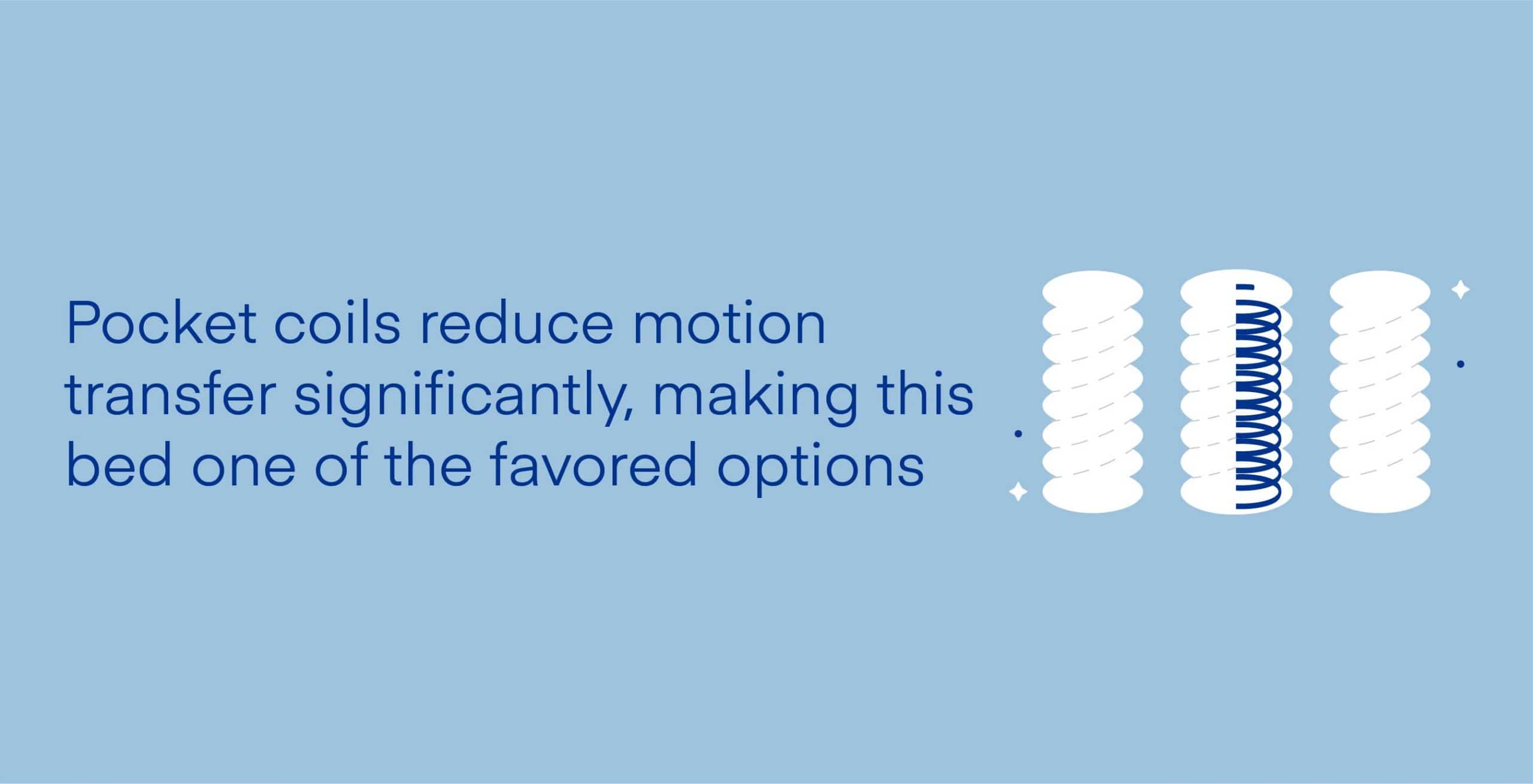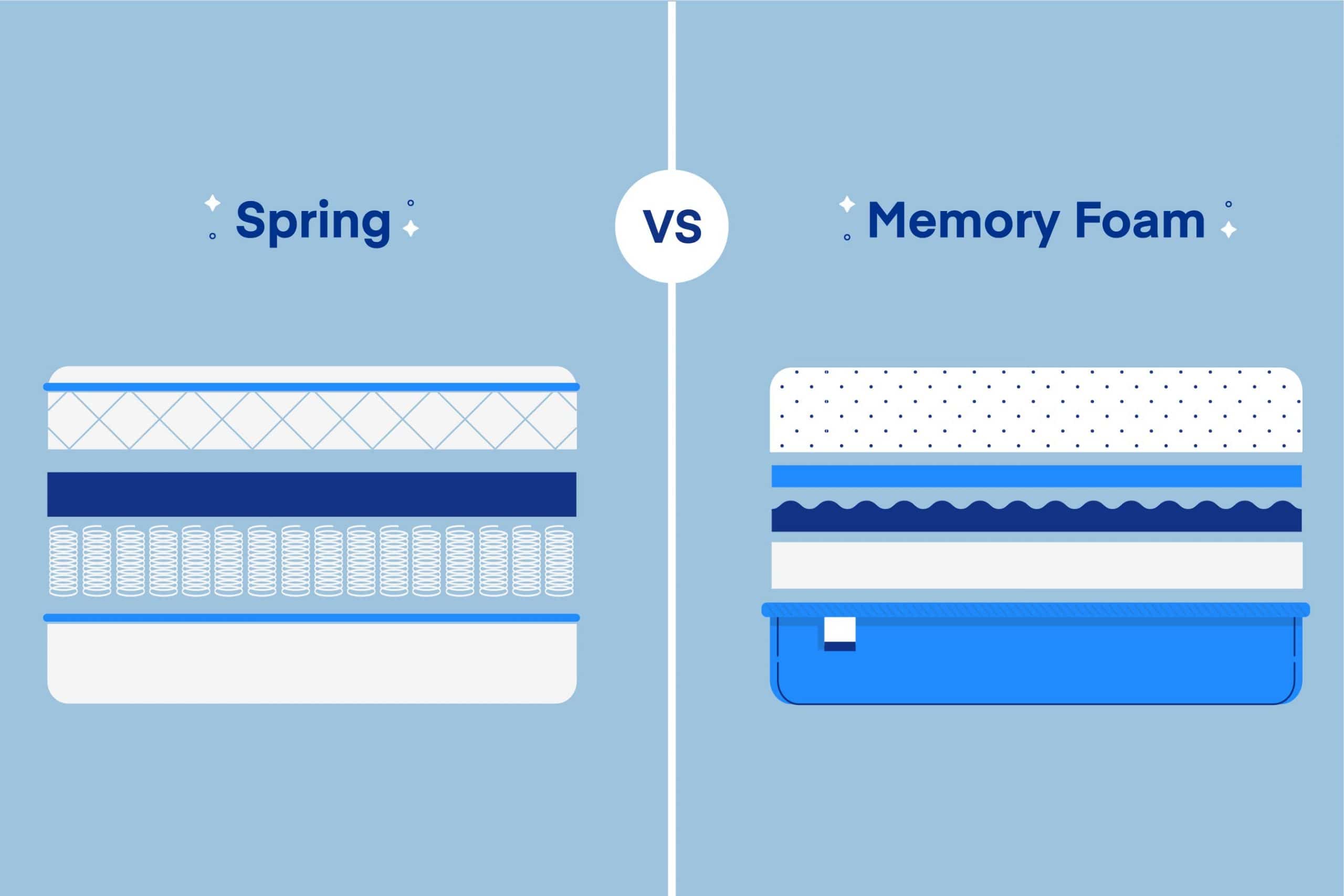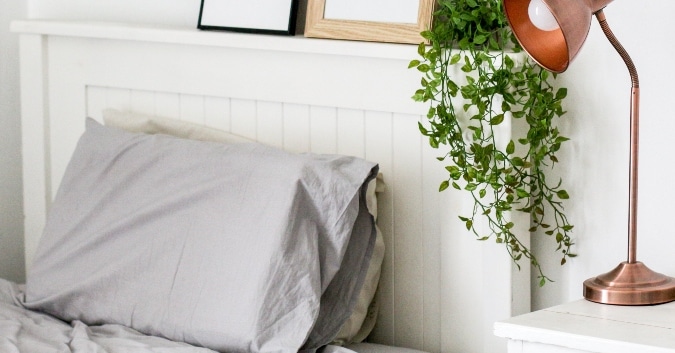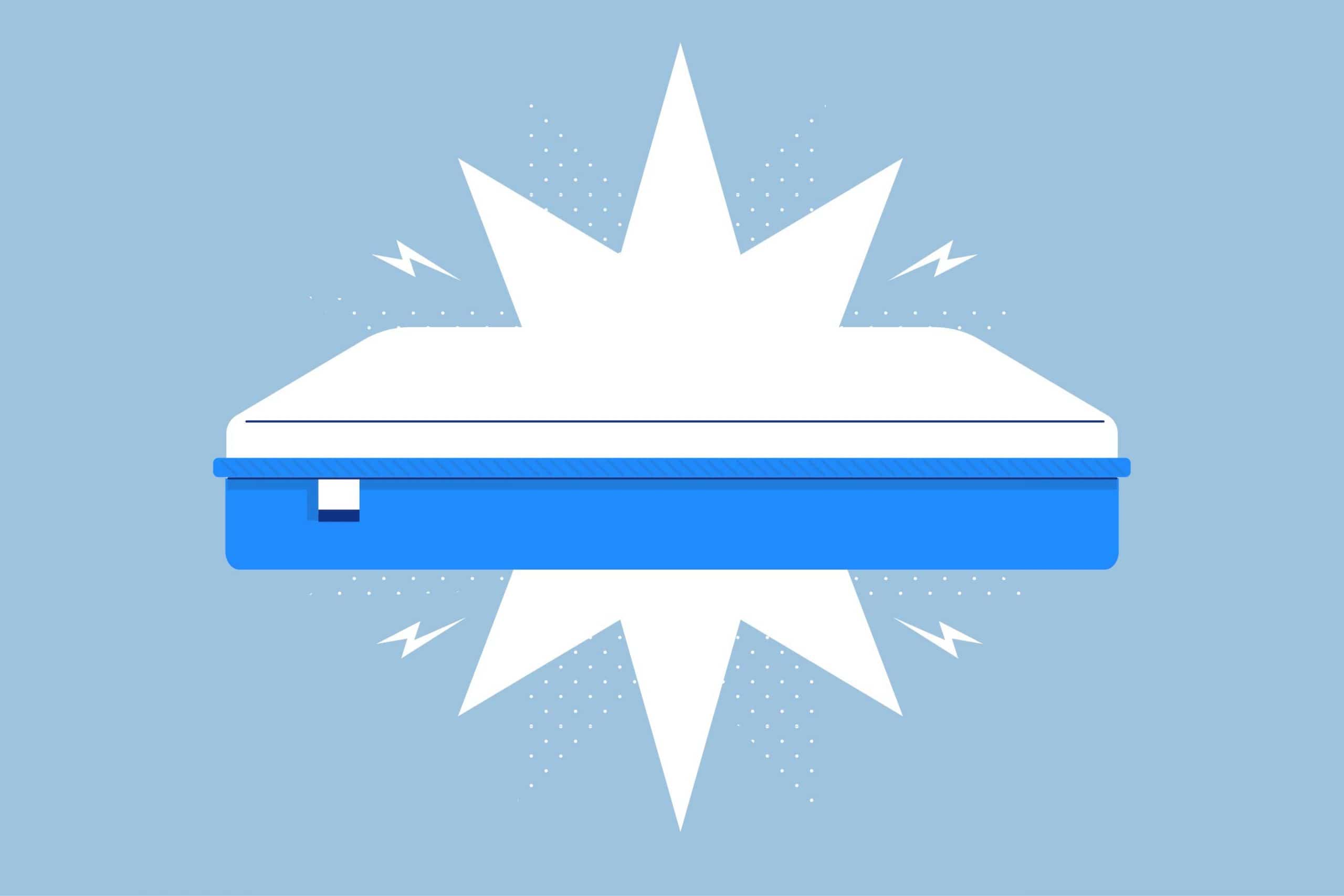The invention of spring mattresses preceded memory foam, but that does not mean one is obsolete while the other is technologically superior. The basic difference between the two types of mattresses is in their feel—while memory foam is more body-conforming and pressure relieving, spring mattresses are bouncier with more give.
Before memory foam was introduced in the 90s, spring beds were popular. The addition of springs offered more support to beds than its predecessor, which used to be large pillows filled with cotton, hay, or down.
Both memory foam and spring mattresses have their benefits and drawbacks. You have to decide which one to choose for a good night’s sleep based on your priorities and preferences. Choosing the best mattress type for your body is important for quality sleep. A 2002 study found that a comfortable bed enhances your sleep quality.
What is Memory Foam?
Memory foam is made by treating polyurethane foam with chemicals to enhance its density and viscosity. Memory foam’s viscoelastic nature allows it to mold to your body while providing pressure-point relief. Memory foam, also known as viscoelastic foam, is temperature and pressure-sensitive.
When you lie on memory foam, your body temperature and weight soften the foam forming around your body almost like a hug. The foam evenly distributes weight on the sleeping surface, relieving your pressure points. Every body part gets support as the contouring foam molds to your curves, making memory foam mattresses a good option for alleviating back pain or joint pains. If you are a back or side sleeper, memory foam provides natural spinal alignment and enhanced lumbar support.
Types of Memory Foam
Memory foam beds respond to your body heat and pressure, but they also tend to trap heat. To beat heat retention, some manufacturers add cooling features like gel, plant oils, copper, or graphite.
Traditional Memory Foam
By its nature, memory foam is open-cell, but some companies expand the cells for even better airflow. This combats the heat retention issue.
Gel Memory Foam
Gel memory foam contains liquid gel or gel beads swirled or infused into the mattress, enhancing its coolness. Gel beads (tiny capsules filled with gel) decrease the temperature of your bed. The gel comprises “phase-changing materials,” also known as “PCM,” which start off as solid and transform into liquid, absorbing your body heat.
The exact constituents of PCM is a closely-guarded secret by mattress manufacturers—it’s made of some synthetic materials and chemicals which are not known to be harmful.
Plant-Based Memory Foam
In plant-based memory foam, a portion of the petroleum is substituted with plant oils, making the bed feel cooler.
Memory Foam with Cooling Additives
Minerals like graphite and copper, known for being good conductors of heat, are added to memory foam to help in dissipating body heat. Additives like these enable you to sleep cool through the night.
What Is a Spring Mattress?
Spring mattresses, also known as innerspring mattresses, were first introduced in 1871 and gained popularity due to their support and bounce. Prior to spring mattresses, beds used to be similar to large pillows stuffed with materials like cotton, hay, wool, or down—not lending sufficient support. Adding a coil layer improves mattress support.
The basic structure of spring mattresses include metal coils or springs for support, which is encased in foam, forming the “support layer.” This layer is topped with upholstery forming the “comfort layer.” The layered upholstery ensures that the sleeper doesn’t feel the coils and springs directly under their body, which may lead to discomfort. The upholstered layer includes a quilted top that determines the mattresses’ plushness and feel. Various types of foam layers, fiber pads, quilts, coils, and springs make up a traditional spring mattress.
While the quilted top, foams, and fiber pads contribute to comfort for sleepers, the coil system lends support and promotes airflow within the mattress, enhancing its breathability. Coil layers of varying densities form the base structure of spring mattresses. Stomach sleepers may benefit from the coil layer because it pushes back preventing their body from arching unnaturally.
The feel of spring mattresses differ from each other depending on factors like spring type, the thickness of the metal used to make it (also known as gauge), spring density, and how they are connected.
Types of Spring Mattresses
Different kinds of springs and coils may be used to make spring mattresses. The way these coils and springs are layered, arranged and connected within a bed determine the different types—such as Bonnell coil, offset coil, continuous coil, pocket coil, coin-on-coil, and innerspring.
Bonnell Coil Mattress
Hourglass-shaped coils form the support layer in this innerspring mattress. These coils are the cheapest amongst spring mattresses, making these beds less durable than other types.
Offset Coil Mattress
Individual coils are connected to each other as they sit very close and tight together forming a coil layer that provides firm support to the mattress. Offset coil mattresses are durable, but the connected coils transfer motion, not making them a good option for couples.
Continuous Coil Mattress
Continuous coils comprise one big wire which is twisted into thousands of coils to form the support layer. While this arrangement makes a very durable bed, it also transfers motion because the entire support layer is very well connected.
Pocket Coil Mattress

Pocket coils mattresses contain innerspring coils individually wrapped in fabric. They are the latest version of coils and are technologically more advanced than the others, making them the most expensive in the spring mattress category. The individual wrappings reduce motion transfer significantly, making this bed one of the favored options.
Coil-on-Coil Mattress
Two layers of coils are stacked on top of each other to enhance the support in a coil-on-coil mattress. The additional layer stacked over the base layer reduces bounce and increases the support in this coil-on-coil mattress.
Differences Between Memory Foam and Spring Mattress
| Parameters | Memory Foam | Spring |
|---|---|---|
| Durability | Memory foam is usually known to be more durable because the lack of coils reduces the risk of sagging. | Spring mattresses may not be as durable as memory foam because the springs and coils may start poking and sagging due to extended use. |
| Support | Memory foam’s body conforming feature allows it to support all body parts uniformly. | Spring mattresses may offer firm support, but they do not apply uniformly to all body parts. |
| Bounce | Usually, the recovery time of memory foam is slow making it low in bounce as compared to spring mattresses. | The spring and coil layer makes spring mattresses bouncier compared to memory foam. |
| Pain-reducing | Memory foam molds to your body and provides pressure relief, alleviating joint and back pain. It aligns with the natural curvature of your spine offering better support. | Spring mattresses are not able to uniformly support the body, causing damage to pressure-points. Springs or coils pressing into already existing pain areas may aggravate the pain. |
| Motion transfer isolation | Memory foam is very good at isolating motion transfer making it a good option for couples or those who sleep with children. | Spring mattresses are usually not good at isolating motion due to the densely connected metal coil layer which transfers motion. |
| Temperature-regulation | Memory foam mattresses tend to retain heat more than other mattress types—to combat this issue, mattress brands infuse cooling technologies into these beds. | The coil layer enhances airflow making for good temperature regulation in spring mattresses. |
| Price | You will find memory foam in a vast price range, depending on the materials used in it. | Spring mattresses are usually less expensive than memory foam. |
A particular mattress type may be more suitable to a certain sleep position or body type than the other. If you don’t choose the right mattress with a certain blend of cushion and support, then your mattress may sag, affecting its durability.
Memory foam beds are available in varying firmness levels for different body types and sleeping positions. While a softer mattress is recommended for lightweight sleepers weighing less than 130 pounds, a firmer mattress usually suits those weighing above 230 pounds so that their weight does not bear down on the mattress giving them a “sinking” feel.
Plus-size sleepers may even benefit from sleeping on a spring mattress because the coil and spring layer enhances the bed’s breathability. Usually, those on the heavier side tend to sleep hot and sweat more—a spring mattress may improve airflow and bounce. The coil layer also offers a much-needed pushback against the weight of a sleeper, preventing them from experiencing a “sinking” feel.
Spring mattresses may not be as durable as memory foam. To counter this disadvantage and to blend in the benefits of other types of beds, the hybrid mattress was born.
Hybrid Mattresses—Blending Innersprings with Other Mattress Types
Hybrid mattresses sport a layer of coils in the support layer like a traditional spring mattress and the comfort layer may be either memory foam or latex. Hybrid beds combine the benefits of two different kinds of beds.
Hybrids usually have pocketed coils, which are individual coils encased in fabric, isolating motion transfer. They also have firmer edge support making it easier to get in and out of the bed, without causing the mattress to sag.
The top comfort layer is made of either memory foam or latex which molds to your body’s curves, providing pressure-point relief and spinal alignment if you are a back sleeper. While enjoying the cradling comfort of memory foam you can reap the benefits of a firmer bounce and increased airflow due to the pocket coil layer in a hybrid bed.
FAQs
Do spring mattresses lead to off-gassing?
Off-gassing refers to the smell of chemicals from new mattresses, which is more prevalent in memory foam mattresses than traditional spring mattresses. Off-gassing isn’t a big concern and it can be remedied by airing out the mattress for a couple of days before using it.
Are hybrid beds suitable for all body types and all kinds of sleepers?
Hybrid mattresses have the advantage of providing both improved airflow and enhanced bounce through the coil layer. The layer of coils is present in the support layer, while the comfort layer may have either memory foam or latex. If you want enhanced breathability and bounce you may choose a hybrid bed irrespective of your body type or sleeping position. You have to decide on the firmness level of the top comfort layer depending on your body type and sleeping position.
Conclusion
With numerous available options, buying the best mattress for yourself may seem like a difficult task. Both memory foam and spring have their advantages and disadvantages. If you’re unable to make up your mind between these two, opting for a hybrid might be best. A high-quality hybrid offers the advantages of two types of mattresses combined in one bed.
About the author
Geoff McKinnen is a writer focusing mainly on the healthcare industry and has written articles on everything from foods to help you lose weight to the connection between Alzheimer’s and sleep. Geoff’s passionate about helping readers improve their well-being to lead happier lives. Outside of work, Geoff enjoys cycling and hiking and believes that by leading a healthy lifestyle, he can help others do the same.
View all posts





